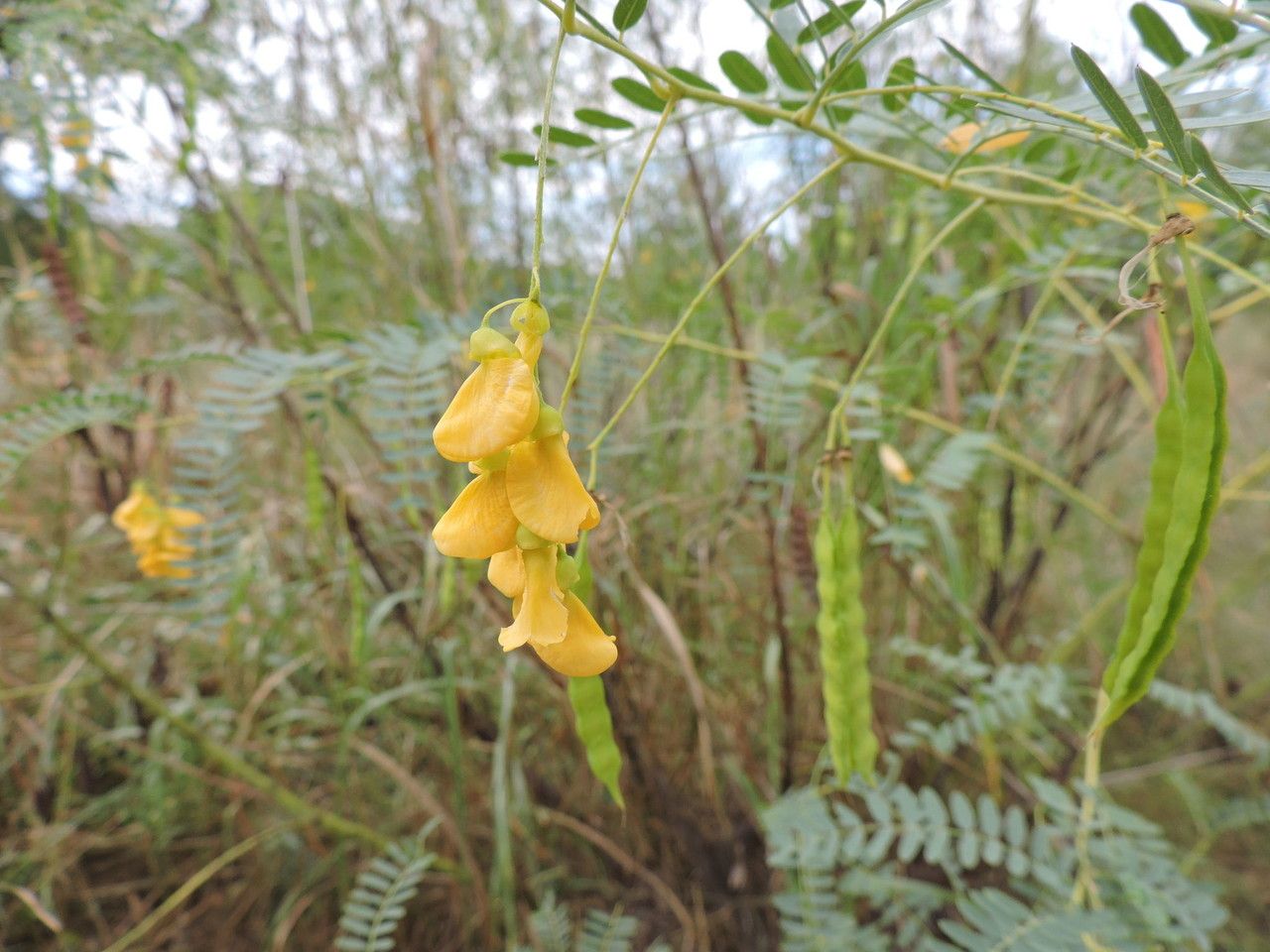Rattlebush
sesbania drummondii
Also known as: ["Rattlebox","Wild Sesbania"]
Overview
A fast-growing, annual legume native to North America, known for its pinnate leaves and yellow, pea-like flowers.
Benefits & Perks
["fast growing","wildlife attractant (bees, butterflies, birds)","drought tolerant"]
Botanical Classification
| Phylum: | Magnoliophyta |
| Class: | Magnoliopsida |
| Order: | Fabales |
| Family: | Fabaceae |
| Genus: | Sesbania |
| Botanical Name: | Sesbania drummondii |
Plant Characteristics
Basic Information
- Category: Flowers
- Suitable Location: outdoor garden bed in full sun
- Suitable For:
- Is Weed: No
- Allergenicity: low
Environmental Needs
- Climate: {"temperatureRange":"15–35°C"}
- Hardiness: {"zones":"8–11"}
- Misting: rarely required, only if ambient humidity is very low
- Drainage: Fast-draining to prevent root rot.
- Soil Type: Well-draining, loamy soil with organic matter.
Maintenance Level
- Maintenance Level: low
- Toughness Level: moderate
- Pruning Frequency: Annually in late winter or early spring; light pruning as needed year-round.
- Pruning Intensity: Moderate; remove up to one-third of growth if overgrown.
Care Details
Ideal Sunlight Coverage:
Full sun (6–8 hours/day); tolerates partial shade but blooms best in direct light.
Sunlight Tolerance Tips:
Acclimate gradually if moving from shade to sun; protect from intense midday sun in hot climates; ensure good air circulation to prevent leaf scorch.
Care Requirements
Care Difficulty
easymoderate
Sunlight
full sun
Rotate plant for even growth; use shade cloth in extreme heat; avoid placing near reflective surfaces.
Watering
every 7–10 days during active growth, reduce in winter
Water thoroughly until runoff, allow soil to dry partially between waterings, and avoid waterlogging.
Soil
well-drained, sandy loam
pH: Slightly acidic to neutral (6.0–7.0).
Avoid heavy clay; ensure good drainage; amend with organic matter for fertility.
Temperature
Thrives in 70–85°F (21–29°C); tolerates heat but may struggle below 50°F (10°C).
Avoid sudden temperature shifts; protect from frost; ensure good air circulation.
Fertilizing
every 4–6 weeks during growing season, none in winter
Dilute fertilizer to half strength; apply to moist soil; avoid contact with roots.
Propagation
Methods
Stem cuttings or seeds.
Step-by-Step Propagation Guide
- Take cutting, apply hormone, plant in medium, maintain humidity, wait for roots.
Best Time: Spring or early summer when growth is active.
Environment
Warm (70–75°F), high humidity, indirect light.
Medium
Well-draining potting mix with perlite or sand.
Hormone
Optional but recommended for faster rooting.
Timeline
Roots in 2–4 weeks; establish in 2–3 months.
Tools Needed
Pruners, rooting hormone, pots, misting spray bottle
Quick Tips
Use healthy, non-flowering stems; keep consistently moist; provide bottom heat if possible.
Pruning & Repotting
Pruning Guide
Method
Selective thinning of branches; heading back to encourage branching.
Pruning Plan
Remove dead or diseased growth; shape plant for better air circulation; encourage bushier growth.
Tools
Pruning shears, loppers, gloves
Checklist
Sterilize tools, prune dead/diseased parts, make clean cuts, dispose of clippings
Repotting Guide
Best Season
Spring, before new growth begins.
Pot Size
One size larger pot (e.g., +2–3 inches in diameter).
Method
Remove plant gently, trim roots if needed, place in new pot with fresh soil, water lightly.
Suggestions
Repot every 2–3 years or when roots fill the pot; beneficial for growth and health.
Checklist
Check root bound status, prepare new pot, trim roots, use fresh soil, water lightly
Advanced Care Tips
Watering Mastery
Watering Checklist
Check soil moisture, water deeply, ensure drainage, avoid wetting leaves
How to Apply Water Properly
Water at the base of the plant, ensuring moisture reaches the root zone without wetting foliage. Water early in the morning to minimize evaporation and fungal issues.
Watering Schedule Tips
Water deeply once every 7–10 days during active growth, reducing frequency to every 2–3 weeks in winter. Adjust based on rainfall and soil moisture retention.
Soil Improvement
Add perlite or sand for drainage; incorporate compost for fertility; ensure good aeration.
Temperature Stress Management
Signs of Temperature Issues
Chlorosis, leaf drop, stunted growth, or wilting in extreme heat or cold.
Cold Stress
Growth slows or halts; leaves may yellow or drop; plant becomes more susceptible to pests.
Solution: Move to a warmer location; apply a thick mulch layer; protect from drafts and frost.
Hot Stress
Wilting, leaf scorch, reduced flowering, or premature bud drop.
Solution: Provide shade during peak heat; increase watering; use mulch to retain soil moisture.
Fertilizing Guide
Fertilizing Checklist
Check season, dilute properly, water before fertilizing, avoid foliage contact
Fertilizing Method
Use balanced liquid fertilizer (10-10-10) every 4–6 weeks during growing season; reduce or stop in winter.
Common Problems & Solutions
Toxicity Warning
Cats
ToxicSesbania drummondii is toxic to cats, particularly its seeds and pods, which contain rotenone and other harmful compounds. Ingestion can result in severe gastrointestinal and neurological distress.
⚠️ Symptoms:
🌿 Toxic Parts:
⚡ Toxic If:
if eaten
Dogs
ToxicThe seeds and pods of Sesbania drummondii are toxic to dogs due to the presence of rotenone and other toxic compounds. Ingestion can lead to severe gastrointestinal and neurological effects.
⚠️ Symptoms:
🌿 Toxic Parts:
⚡ Toxic If:
if eaten
Humans
ToxicSesbania drummondii contains rotenone and other toxic compounds that can cause significant physiological effects upon ingestion. These compounds interfere with cellular respiration, leading to systemic toxicity.
⚠️ Symptoms:
🌿 Toxic Parts:
⚡ Toxic If:
if eaten
Frequently Asked Questions
Q: Is Rattlebush toxic to pets?
A: Yes, it is mildly toxic to dogs and cats if ingested.
Q: Does Rattlebush attract wildlife?
A: Yes, it attracts bees, butterflies, and birds due to its flowers.
Q: How fast does Rattlebush grow?
A: It is a fast-growing plant, often reaching maturity within a single growing season.
Quick Reference
| Family: | Fabaceae |
| Care: | easy |
| Light: | full sun |
| Water: | every 7–10 days during activ |
Get Expert Care Tips
Download the Plantious app for personalized care reminders and plant identification!
Google Play App Store






